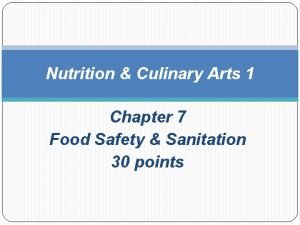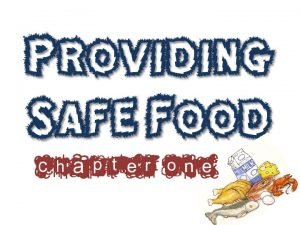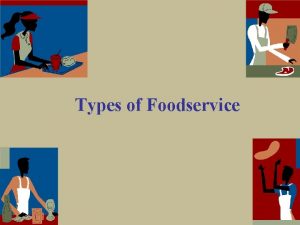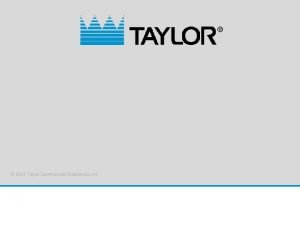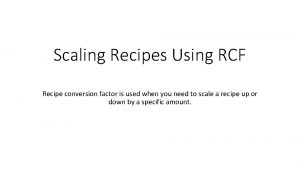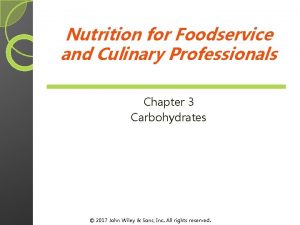Nutrition for Foodservice and Culinary Professionals Chapter 12

































- Slides: 33

Nutrition for Foodservice and Culinary Professionals Chapter 12 Weight Management © 2013 John Wiley & Sons, Inc. All rights reserved.

Learning Objectives �Explain how you gain or lose weight, and discuss at least two factors that play a role in the development of obesity. �Define overweight and obesity, and determine how much you should weigh. �Recognize risks of being obese. �Describe how to use the following components of a weight loss program to lose weight: eating plan, exercise, behavior and attitude modification, and support. © 2013 John Wiley & Sons, Inc. All rights reserved.

Introduction to Weight Management �Overweight and obesity are among the most pressing challenges in the United States. �In 2010, 18 percent of children ages 6 to 19 were obese. In the 1970 s, only 4 to 6 percent were obese. �More than double the number of adults were obese in 2010 when compared to the 1970 s. © 2013 John Wiley & Sons, Inc. All rights reserved.

What Is Kcalorie Balance? �Kcalorie balance refers to the relationship between the kcalories you take in from food and beverages and the kcalories you use through physical activity and your basal metabolism. �If kcalories consumed = kcalories used, then you maintain the same body weight. �If you eat fewer kcalories than you use, then you lose weight. �If you eat more kcalories than you use, then you gain weight. © 2013 John Wiley & Sons, Inc. All rights reserved.

Factors that play a role in obesity: �Behavioral—choices you make in eating and exercise �Cultural �Socioeconomic �Genetics �Other diseases/conditions � ◦ ◦ Environmental Increase in portion sizes Limited access to healthy affordable foods Lack of safe places to be active Greater availability of high kcalorie foods © 2013 John Wiley & Sons, Inc. All rights reserved.

How Much Should I Weigh? �Body Mass Index ◦ A measure of weight relative to height. ◦ A reasonably reliable indicator of total body fat—which is related to the risk of disease and death. Obese: BMI of 30 or greater Overweight: BMI of 25 to 29. 9 © 2013 John Wiley & Sons, Inc. All rights reserved.

How Much Should I Weigh? (cont’d) �Because BMI doesn’t tell you how much of your excess weight is fat, a physician will also measure your waist circumference. �Excessive abdominal fat is more healththreatening than fat in the hips or thighs. �Women—desirable to keep waist below 35 inches �Men—desirable to keep waist below 40 inches © 2013 John Wiley & Sons, Inc. All rights reserved.

Body Fat % �For men—desirable percentage of body fat is under 25 (22% if under 40 years of age) �For women—desirable percentage of body fat is under 35% (32% if under 40 years of age) © 2013 John Wiley & Sons, Inc. All rights reserved.

How Obesity Affects Your Health �An ◦ ◦ ◦ ◦ obese individual is at increased risk for: Type 2 diabetes High blood cholesterol levels High blood pressure Losing weight often Heart disease decreases blood pressure and cholesterol levels. Stroke Certain types of cancer Liver and gallbladder disease Sleep apnea © 2013 John Wiley & Sons, Inc. All rights reserved.

How to Lose Weight �You need to eat and drink fewer kcalories and/or burn more kcalories in physical activity. �Set a realistics weight loss goal—from ½ to 1 pound/week. �To lose 1 pound/week, you will need to cut back about 500 kcalories/day. �Even modest weight loss can produce health benefits—lower cholesterol, blood pressure, etc. © 2013 John Wiley & Sons, Inc. All rights reserved.

Components of a weight loss program: A. B. C. D. E. Eating plan Exercise Behavioral and attitude modification Social support Support to maintain weight loss © 2013 John Wiley & Sons, Inc. All rights reserved.

A. Eating Plan �People who lose weight gradually and steadily (about 1 to 2 pounds/week) are more successful at keeping it off. �Weight loss isn’t just about a “diet”—it’s about an ongoing lifestyle that includes long-term changes in daily eating and exercise habits. © 2013 John Wiley & Sons, Inc. All rights reserved.

A. Eating Plan (cont’d) �Your food choices should: ◦ Emphasize fruits, vegetables, whole grains, and fat-free or low-fat milk and milk products ◦ Include lean meats, poultry, fish, beans, eggs, and nuts ◦ Be low in saturated fats, trans fats, cholesterol, sodium, and added sugars �One diet is no better than the next when it comes to weight loss, as long as you are eating fewer kcalories and taking in adequate nutrients through the foods listed above. © 2013 John Wiley & Sons, Inc. All rights reserved.

A. Eating Plan (cont’d) �A dieter who severely restricts kcalories will lose more muscle tissue than is desirable. �Since muscle uses more kcalories than fat, you wind up with a lower basal metabolic rate—and this makes it easier to regain weight. © 2013 John Wiley & Sons, Inc. All rights reserved.

Weigh yourself frequently—at least weekly. © 2013 John Wiley & Sons, Inc. All rights reserved.

Eating Tips �No foods should be forbidden because that only makes them more attractive. �To cut kcalories without feeling hungry, you need to replace some higher kcalorie foods with foods that are lower in kcalories and fat and will fill you up—choose foods with lots of water and fiber such as fruits, vegetables, broth-based soups, whole grains, and legumes. © 2013 John Wiley & Sons, Inc. All rights reserved.

Eating Tips (cont’d) �Also eat smaller portions. �Pay more attention to how hungry you are rather than how much food is on the plate. �Don’t skip breakfast! �Low-fat and fat-free foods are not necessarily low in kcalories. �Avoid fried foods. © 2013 John Wiley & Sons, Inc. All rights reserved.

Eating Tips (cont’d) �Choose your carbohydrates carefully—pick fruits, vegetables, whole grains, and dairy. Fiber in these foods will help you feel full. Limit foods with added sugars and primarily white flour. �No foods can burn fat. �Drink plenty of fluids. �Watch out for empty kcalories in alcoholic beverages and mixers, as well as fancy coffee drinks. © 2013 John Wiley & Sons, Inc. All rights reserved.

Very-low-kcalorie diet �A very-low-kcalorie diet is a doctor supervised diet that usually uses commercially prepared formulas to promote rapid weight loss in obese patients. �The formulas—usually liquid shakes or bars— replace all food intake for several weeks or months. They are fortified with nutrients. © 2013 John Wiley & Sons, Inc. All rights reserved.

B. Exercise �When losing weight, more physical activity increases the number of kcalories you body uses for energy—you burn more kcalories during the activity and also for a few hours after vigorous prolonged activity. �Dieters who exercise tend to lose more fat and retain more muscle. They are also more likely to follow their diet plans and keep the weight off. © 2013 John Wiley & Sons, Inc. All rights reserved.

Benefits of Exercise �Reduces high blood pressure �Reduces risk for type 2 diabetes, heart attack, stroke, and several forms of cancer �Reduces arthritis pain �Reduces risk for osteoporosis and falls �Reduces symptoms of depression and anxiety �Improves psychological well-being �Increases stamina and resistance to fatigue © 2013 John Wiley & Sons, Inc. All rights reserved.

How much exercise do you need to do? �To maintain your weight— 2½ hours of moderate intensity or 75 minutes of vigorous intensity each week �To lose weight— 250 to 300 minutes/week of moderate-intensity The optimal fitness routine includes aerobic training, strength-training, and stretching activities. © 2013 John Wiley & Sons, Inc. All rights reserved.

Factors that Play a Role in Obesity Moderate Intensity � Hiking � Yard work � Dancing � Golf (walking and carrying clubs) � Biking less than 10 mph � Walking 3. 5 mph � Weight training � Stretching Vigorous Intensity � Running � Biking over 10 mph � Swimming � Aerobics � Walking 4 mph � Heavy yard work � Weight lifting � Basketball (vigorous) © 2013 John Wiley & Sons, Inc. All rights reserved.

C. Behavior and Attitude Modification � Behavior modification—changing some of your behaviors so that you lose weight ◦ Set goals that are specific, realistic, and forgiving, such as walking 30 minutes a day, 5 times a week. ◦ Self-monitoring �Keep a food diary to increase awareness of what you are really eating and why. �Hunger is a physical need for food, whereas appetite is a psychological need. Eat in response to hunger. �Through self-monitoring, cues, or stimuli to overeating can be identified. © 2013 John Wiley & Sons, Inc. All rights reserved.

Tips: Stimulus or Cue Control �Plan meals. �Make a shopping list. �Do food shopping after eating. �Store food out of sight. �Keep low-kcal snacks on hand. �Do not serve food at the table. �Leave the table right after eating. © 2013 John Wiley & Sons, Inc. All rights reserved.

Modifying Eating Behaviors �Only let yourself eat in 1 or 2 places, such as at the kitchen or dining room table—don’t eat in bed, in front of TV, etc. �Plan regular meals and snack. �Eat slowly. �Take smaller bites—savor each bite. �Use a smaller plate—don’t clean your plate. © 2013 John Wiley & Sons, Inc. All rights reserved.

Reward Yourself �Reward yourself for positive steps—but don’t use food! �Pick something that is desirable and timely. © 2013 John Wiley & Sons, Inc. All rights reserved.

Eating Due to Stress �To relieve stress, you can exercise or use relaxation techniques. �You can switch to a new activity when you need to get your mind off food. �If you want to grab a cookie, for instance, give yourself five minutes before you do it. In that time you will likely go on to something else and forget about the food. © 2013 John Wiley & Sons, Inc. All rights reserved.

Attitude Modification �Unrealistic statements: ◦ I will always control my desire for chocolate. ◦ I will exercise every day. �Goals stated like this decrease the likelihood that you will accomplish them. �Avoid terms such as “always, ” “never, ” and “every. ” �If you do overeat, stay calm, realize no one is perfect and tomorrow is another day. © 2013 John Wiley & Sons, Inc. All rights reserved.

D. Support �Family and friends �Internet and technology: exercise and weight reduction applications �My. Fitness. Pal �Lose. It © 2013 John Wiley & Sons, Inc. All rights reserved.

E. Maintenance Support � Continue to follow a healthy eating pattern lower in kcal when compared to diet prior to weight loss. � Keep eating patterns consistent regardless of changes in your routine (weekends). � Eat breakfast every day. � Keep monitoring your kcal and activity. � Exercise 30 to 60 minutes/day. � Watch less than 10 hours of TV/week. � Monitor your weight at least weekly. � Continue to get support form family, friends and others. © 2013 John Wiley & Sons, Inc. All rights reserved.

Hot Topic: Weight Loss Myths �Fad diets are not the best way to lose weight and keep it off. �Starches are not necessarily fattening—many foods high in starch, such as whole grain bread, are low in fat and kcalories. �Reduced kcalorie diets result in weight loss regardless of whether they are low in carbohydrate, fat, or protein. �A weight loss product that claims to be “natural” or “herbal” is not necessarily safe. © 2013 John Wiley & Sons, Inc. All rights reserved.

Hot Topic: Weight Loss Myths (cont’d) �No food can burn fat. �A low-fat or fat-free food may be lower in kcalories than the same size portion of the full-fat product, but many contain just as many kcalories. �Fast foods can be part of a healthy weight-loss program. �Skipping breakfast does not help you lose weight. �In small amounts, nuts can be part of a healthy weight-loss program. © 2013 John Wiley & Sons, Inc. All rights reserved.
 Nutrition for foodservice and culinary professionals
Nutrition for foodservice and culinary professionals Nutrition for foodservice and culinary professionals
Nutrition for foodservice and culinary professionals Nutrition for foodservice and culinary professionals
Nutrition for foodservice and culinary professionals Chapter 11 culinary nutrition
Chapter 11 culinary nutrition Culinary nutrition definition
Culinary nutrition definition Chapter 3 foodservice career options
Chapter 3 foodservice career options Understanding foodservice operations chapter 2
Understanding foodservice operations chapter 2 Sustainability in the restaurant and foodservice industry
Sustainability in the restaurant and foodservice industry Which food is a tcs food
Which food is a tcs food Chapter 4 becoming a culinary professional answers
Chapter 4 becoming a culinary professional answers Chapter 14 culinary math
Chapter 14 culinary math Types of foodservice
Types of foodservice Production sheets food service
Production sheets food service Example of institutional catering
Example of institutional catering Commercial and noncommercial food service operations
Commercial and noncommercial food service operations Penyelenggaraan makanan non komersial
Penyelenggaraan makanan non komersial Lincoln foodservice products
Lincoln foodservice products Business of making and serving prepared food and drink.
Business of making and serving prepared food and drink. When installing tabletop equipment on legs
When installing tabletop equipment on legs Taylor commercial foodservice
Taylor commercial foodservice Nnn foodservice solutions
Nnn foodservice solutions Culinary crossword 9.1 eggs and dairy
Culinary crossword 9.1 eggs and dairy Strategic & competitive intelligence professionals
Strategic & competitive intelligence professionals Families professionals and exceptionality
Families professionals and exceptionality Ctip clause that must be included in every contract
Ctip clause that must be included in every contract Families professionals and exceptionality
Families professionals and exceptionality Mandoline definition
Mandoline definition Chef culinary conference
Chef culinary conference Mother sauces and their derivatives
Mother sauces and their derivatives Conversion factor in cooking
Conversion factor in cooking Harbor city community college
Harbor city community college 7 parts of a standardized recipe
7 parts of a standardized recipe Culinary terms
Culinary terms Arims labels
Arims labels




